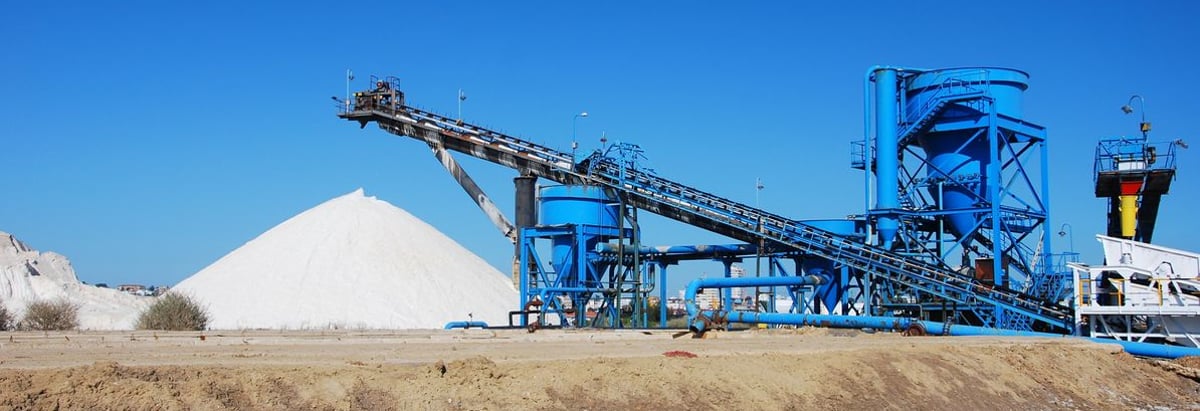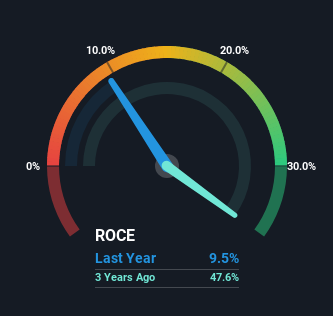- South Korea
- /
- Trade Distributors
- /
- KOSDAQ:A162300
Investors Could Be Concerned With Shin SteelLtd's (KOSDAQ:162300) Returns On Capital

What trends should we look for it we want to identify stocks that can multiply in value over the long term? Amongst other things, we'll want to see two things; firstly, a growing return on capital employed (ROCE) and secondly, an expansion in the company's amount of capital employed. This shows us that it's a compounding machine, able to continually reinvest its earnings back into the business and generate higher returns. Although, when we looked at Shin SteelLtd (KOSDAQ:162300), it didn't seem to tick all of these boxes.
Return On Capital Employed (ROCE): What Is It?
For those who don't know, ROCE is a measure of a company's yearly pre-tax profit (its return), relative to the capital employed in the business. The formula for this calculation on Shin SteelLtd is:
Return on Capital Employed = Earnings Before Interest and Tax (EBIT) ÷ (Total Assets - Current Liabilities)
0.095 = ₩10b ÷ (₩230b - ₩119b) (Based on the trailing twelve months to December 2024).
Thus, Shin SteelLtd has an ROCE of 9.5%. On its own that's a low return, but compared to the average of 7.7% generated by the Trade Distributors industry, it's much better.
View our latest analysis for Shin SteelLtd

While the past is not representative of the future, it can be helpful to know how a company has performed historically, which is why we have this chart above. If you'd like to look at how Shin SteelLtd has performed in the past in other metrics, you can view this free graph of Shin SteelLtd's past earnings, revenue and cash flow.
The Trend Of ROCE
On the surface, the trend of ROCE at Shin SteelLtd doesn't inspire confidence. Over the last five years, returns on capital have decreased to 9.5% from 16% five years ago. However, given capital employed and revenue have both increased it appears that the business is currently pursuing growth, at the consequence of short term returns. And if the increased capital generates additional returns, the business, and thus shareholders, will benefit in the long run.
On a related note, Shin SteelLtd has decreased its current liabilities to 52% of total assets. So we could link some of this to the decrease in ROCE. What's more, this can reduce some aspects of risk to the business because now the company's suppliers or short-term creditors are funding less of its operations. Some would claim this reduces the business' efficiency at generating ROCE since it is now funding more of the operations with its own money. Keep in mind 52% is still pretty high, so those risks are still somewhat prevalent.
What We Can Learn From Shin SteelLtd's ROCE
While returns have fallen for Shin SteelLtd in recent times, we're encouraged to see that sales are growing and that the business is reinvesting in its operations. And there could be an opportunity here if other metrics look good too, because the stock has declined 10% in the last five years. So we think it'd be worthwhile to look further into this stock given the trends look encouraging.
Since virtually every company faces some risks, it's worth knowing what they are, and we've spotted 3 warning signs for Shin SteelLtd (of which 2 are a bit concerning!) that you should know about.
While Shin SteelLtd isn't earning the highest return, check out this free list of companies that are earning high returns on equity with solid balance sheets.
New: Manage All Your Stock Portfolios in One Place
We've created the ultimate portfolio companion for stock investors, and it's free.
• Connect an unlimited number of Portfolios and see your total in one currency
• Be alerted to new Warning Signs or Risks via email or mobile
• Track the Fair Value of your stocks
Have feedback on this article? Concerned about the content? Get in touch with us directly. Alternatively, email editorial-team (at) simplywallst.com.
This article by Simply Wall St is general in nature. We provide commentary based on historical data and analyst forecasts only using an unbiased methodology and our articles are not intended to be financial advice. It does not constitute a recommendation to buy or sell any stock, and does not take account of your objectives, or your financial situation. We aim to bring you long-term focused analysis driven by fundamental data. Note that our analysis may not factor in the latest price-sensitive company announcements or qualitative material. Simply Wall St has no position in any stocks mentioned.
About KOSDAQ:A162300
Shin SteelLtd
A steel distribution company, engages in the supplying of various steel products for applications in home appliances and construction fields.
Mediocre balance sheet low.
Market Insights
Community Narratives



